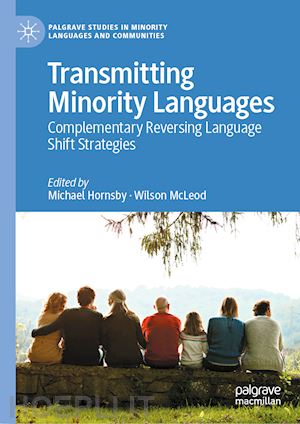
Questo prodotto usufruisce delle SPEDIZIONI GRATIS
selezionando l'opzione Corriere Veloce in fase di ordine.
Pagabile anche con Carta della cultura giovani e del merito, 18App Bonus Cultura e Carta del Docente
This book gives fresh insight into the diverse ways in which the transmission of minority and heritage languages is carried out in a range of sociolinguistic contexts. When traditional modes of intergenerational transmission begin to break down, minority language and diaspora communities resort to other modes of transmission, out of necessity, to complement traditional mechanisms and secure language maintenance. This volume brings together a broad range of studies of these alternative modes of transmission, examining the complex and diverse practical, ideological and personal challenges that arise in different settings. Beyond addressing the dynamics of language use within the home and family, the book also emphasises the importance of the participation of the minority community itself in language and cultural transmission. These mechanisms and initiatives, sometimes overlooked or dismissed in the academic literature, will prove to be essential in maintaining and ensuring the survival of minority and heritage languages into the 21st century and beyond. The twelve chapters in the book are divided into four sections (intergenerational transmission; transmission in post-traditional families; alternatives to ‘traditional’ transmission; and transmission in diasporic contexts), and the language contexts, both minoritised and diasporic, which are discussed include Basque, Breton, Galician, Guernesais, Irish, Maori, Russian, Scottish Gaelic, Sorbian and Spanish. This book will be of interest to students and scholars of sociolinguistics, language acquisition, heritage language maintenance and revitalization, and language policy and planning.
Chapter 1. Introduction.- Part I: Intergenerational transmission.- Chapter 2. Tús Maith, A Good Start: Intervention and Intergenerational Transmission in the Corca Dhuibhne Gaeltacht.- Chapter 3. Family language policy in the face of a shrinking community language: Gaelic on the Isle of Lewis.- Part II: Transmission in post-traditional families.- Chapter 4. The transmission of Breton in the family: the effect of family rupture and recomposition.- Chapter 5. The importance of wider community stance for Irish-speaking families in the Gaeltacht.- Part III: Alternatives to ‘traditional’ transmission.- Chapter 6. Native and non-native speakers school language practices and transmission in Upper Lusatia.- Chapter 7. Kura Whakarauora: Flax-roots language planning for families in Aotearoa/New Zealand.- Chapter 8. Peer-to-peer language transmission among adults.- Chapter 9. New ways of looking at minority language transmission from the Basque context.- Chapter 10. Transmission of Breton among immersion-school students: the impact of home language.- Part IV: Transmission in diasporic contexts. Chapter 11. Comparing family language policy in Sweden, Cyprus and Estonia: efforts and choices among Russian-speaking families.- Chapter 12. Effective family language policies and intergenerational transmission of minority languages: Parental language management from autochthonous and diasporic contexts.- Chapter 13. ‘We had to make a choice’: Language management in Italian transnational adoptive.- Chapter 14. Conclusion.- Index.











Il sito utilizza cookie ed altri strumenti di tracciamento che raccolgono informazioni dal dispositivo dell’utente. Oltre ai cookie tecnici ed analitici aggregati, strettamente necessari per il funzionamento di questo sito web, previo consenso dell’utente possono essere installati cookie di profilazione e marketing e cookie dei social media. Cliccando su “Accetto tutti i cookie” saranno attivate tutte le categorie di cookie. Per accettare solo deterninate categorie di cookie, cliccare invece su “Impostazioni cookie”. Chiudendo il banner o continuando a navigare saranno installati solo cookie tecnici. Per maggiori dettagli, consultare la Cookie Policy.